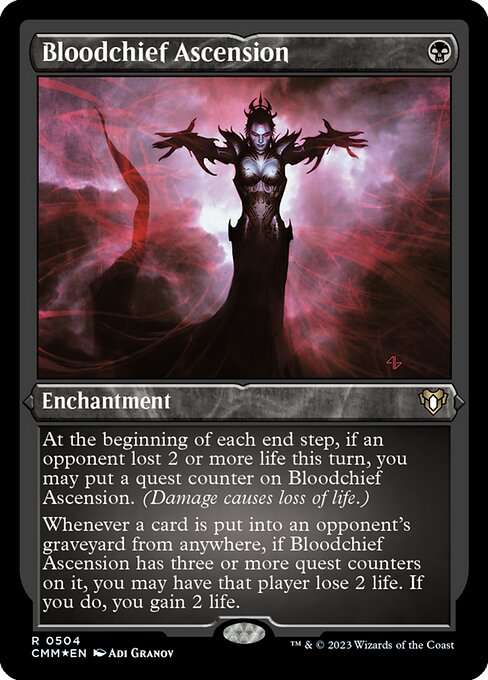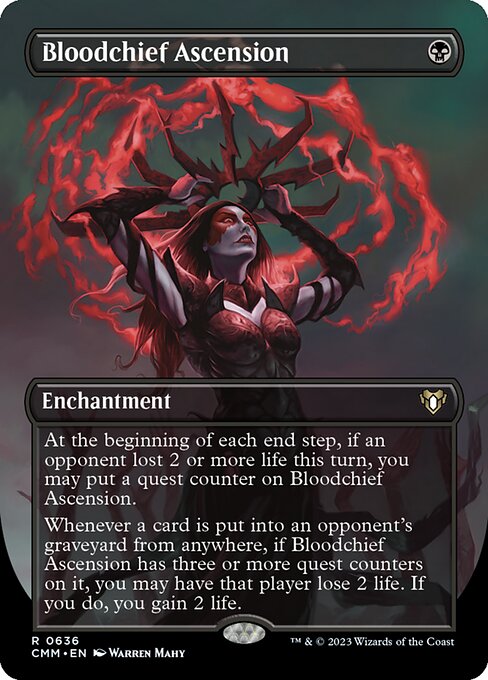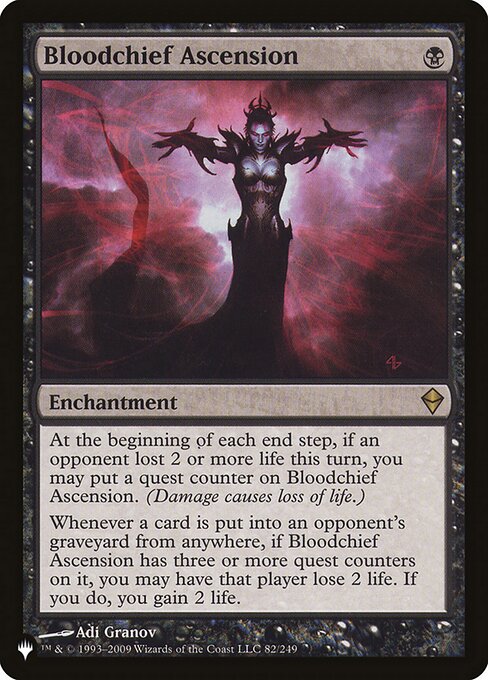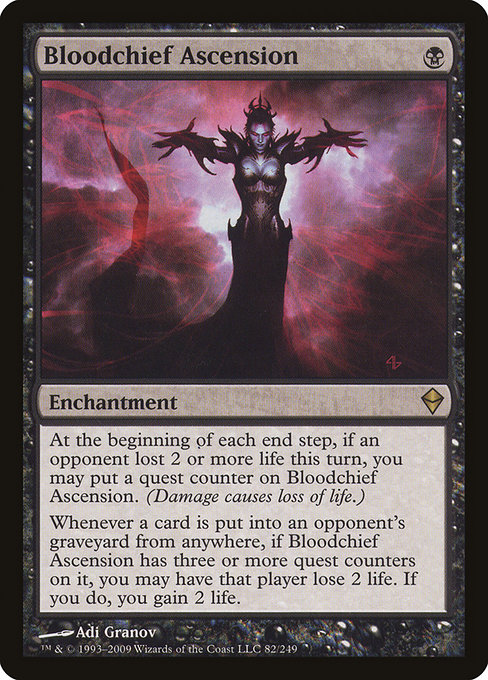Ascensione del Capo Sanguinario
Incantesimo
All'inizio di ogni sottofase finale, se un avversario ha perso 2 o più punti vita in questo turno, puoi mettere un segnalino ricerca sull'Ascensione del Capo Sanguinario. (Il danno provoca la perdita di punti vita.)
Ogniqualvolta una carta viene messa nel cimitero di un avversario da qualsiasi zona, se l'Ascensione del Capo Sanguinario ha tre o più segnalini ricerca, puoi far perdere 2 punti vita a quel giocatore. Se lo fai, guadagni 2 punti vita.
Ogniqualvolta una carta viene messa nel cimitero di un avversario da qualsiasi zona, se l'Ascensione del Capo Sanguinario ha tre o più segnalini ricerca, puoi far perdere 2 punti vita a quel giocatore. Se lo fai, guadagni 2 punti vita.
standard
future
historic
gladiator
pioneer
explorer
modern
legacy
pauper
vintage
penny
commander
brawl
alchemy
paupercommander
duel
oldschool
premodern
Rulings
Bloodchief Ascension’s first ability has an “intervening ‘if’ clause.” It won’t trigger at all unless an opponent has already lost 2 or more life by the time the end step begins.
For the first ability to trigger, a single opponent must have lost 2 life. Two opponents each losing 1 life won’t cause it to trigger. It will trigger a maximum of once per turn, no matter how many opponents have lost 2 or more life.
Bloodchief Ascension’s second ability doesn’t behave like a leaves-the-battlefield triggered ability, since the card put into an opponent’s graveyard may come from anywhere. If a Bloodchief Ascension with three quest counters on it and a permanent an opponent owns are destroyed at the same time, for example, the game will not “look back in time” at the game state, and Bloodchief Ascension’s second ability won’t trigger.
Bloodchief Ascension’s first ability checks only whether life was lost. It doesn’t care whether life was also gained. For example, if an opponent lost 4 life and gained 6 life during the turn, that player will have a higher life total than they started the turn with — but Bloodchief Ascension’s first ability will still trigger.
Bloodchief Ascension’s first ability checks how much life was lost by each opponent over the course of the entire turn, even if Bloodchief Ascension wasn’t on the battlefield the whole time.
For the first ability to trigger, a single opponent must have lost 2 life. Two opponents each losing 1 life won’t cause it to trigger. It will trigger a maximum of once per turn, no matter how many opponents have lost 2 or more life.
Bloodchief Ascension’s second ability doesn’t behave like a leaves-the-battlefield triggered ability, since the card put into an opponent’s graveyard may come from anywhere. If a Bloodchief Ascension with three quest counters on it and a permanent an opponent owns are destroyed at the same time, for example, the game will not “look back in time” at the game state, and Bloodchief Ascension’s second ability won’t trigger.
Bloodchief Ascension’s first ability checks only whether life was lost. It doesn’t care whether life was also gained. For example, if an opponent lost 4 life and gained 6 life during the turn, that player will have a higher life total than they started the turn with — but Bloodchief Ascension’s first ability will still trigger.
Bloodchief Ascension’s first ability checks how much life was lost by each opponent over the course of the entire turn, even if Bloodchief Ascension wasn’t on the battlefield the whole time.
Rulings
Bloodchief Ascension’s first ability has an “intervening ‘if’ clause.” It won’t trigger at all unless an opponent has already lost 2 or more life by the time the end step begins.
For the first ability to trigger, a single opponent must have lost 2 life. Two opponents each losing 1 life won’t cause it to trigger. It will trigger a maximum of once per turn, no matter how many opponents have lost 2 or more life.
Bloodchief Ascension’s second ability doesn’t behave like a leaves-the-battlefield triggered ability, since the card put into an opponent’s graveyard may come from anywhere. If a Bloodchief Ascension with three quest counters on it and a permanent an opponent owns are destroyed at the same time, for example, the game will not “look back in time” at the game state, and Bloodchief Ascension’s second ability won’t trigger.
Bloodchief Ascension’s first ability checks only whether life was lost. It doesn’t care whether life was also gained. For example, if an opponent lost 4 life and gained 6 life during the turn, that player will have a higher life total than they started the turn with — but Bloodchief Ascension’s first ability will still trigger.
Bloodchief Ascension’s first ability checks how much life was lost by each opponent over the course of the entire turn, even if Bloodchief Ascension wasn’t on the battlefield the whole time.
For the first ability to trigger, a single opponent must have lost 2 life. Two opponents each losing 1 life won’t cause it to trigger. It will trigger a maximum of once per turn, no matter how many opponents have lost 2 or more life.
Bloodchief Ascension’s second ability doesn’t behave like a leaves-the-battlefield triggered ability, since the card put into an opponent’s graveyard may come from anywhere. If a Bloodchief Ascension with three quest counters on it and a permanent an opponent owns are destroyed at the same time, for example, the game will not “look back in time” at the game state, and Bloodchief Ascension’s second ability won’t trigger.
Bloodchief Ascension’s first ability checks only whether life was lost. It doesn’t care whether life was also gained. For example, if an opponent lost 4 life and gained 6 life during the turn, that player will have a higher life total than they started the turn with — but Bloodchief Ascension’s first ability will still trigger.
Bloodchief Ascension’s first ability checks how much life was lost by each opponent over the course of the entire turn, even if Bloodchief Ascension wasn’t on the battlefield the whole time.
Votre collection ? vos decks ?
Envie de gérer votre collection et/ou créer des decks ?
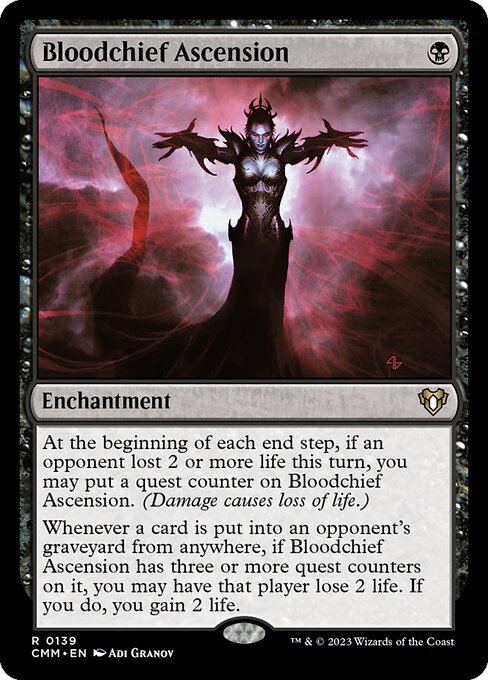

 0
0
 12.51€
12.51€
